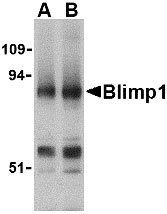Blimp-1 Antibody
- 产品详情
- 实验流程
- 背景知识
Application
| WB, E, IHC-P |
|---|---|
| Primary Accession | O75626 |
| Other Accession | NP_001189, 172072684 |
| Reactivity | Human, Mouse, Rat |
| Host | Rabbit |
| Clonality | Polyclonal |
| Isotype | IgG |
| Calculated MW | 91771 Da |
| Concentration (mg/ml) | 1 mg/mL |
| Conjugate | Unconjugated |
| Application Notes | Blimp-1 antibody can be used for detection of Blimp-1 by Western blot at 0.5 - 1 µg/mL. Antibody can also be used for immunohistochemistry starting at 5 µg/mL. |
| Gene ID | 639 |
|---|---|
| Other Names | Blimp-1 Antibody: BLIMP1, PRDI-BF1, BLIMP1, PR domain zinc finger protein 1, BLIMP-1, PR domain containing 1, with ZNF domain |
| Target/Specificity | PRDM1; |
| Reconstitution & Storage | Blimp-1 antibody can be stored at 4℃ for three months and -20℃, stable for up to one year. As with all antibodies care should be taken to avoid repeated freeze thaw cycles. Antibodies should not be exposed to prolonged high temperatures. |
| Precautions | Blimp-1 Antibody is for research use only and not for use in diagnostic or therapeutic procedures. |
| Name | PRDM1 |
|---|---|
| Synonyms | BLIMP1 |
| Function | Transcription factor that mediates a transcriptional program in various innate and adaptive immune tissue-resident lymphocyte T cell types such as tissue-resident memory T (Trm), natural killer (trNK) and natural killer T (NKT) cells and negatively regulates gene expression of proteins that promote the egress of tissue-resident T-cell populations from non-lymphoid organs. Plays a role in the development, retention and long-term establishment of adaptive and innate tissue- resident lymphocyte T cell types in non-lymphoid organs, such as the skin and gut, but also in other nonbarrier tissues like liver and kidney, and therefore may provide immediate immunological protection against reactivating infections or viral reinfection (By similarity). Binds specifically to the PRDI element in the promoter of the beta- interferon gene (PubMed:1851123). Drives the maturation of B- lymphocytes into Ig secreting cells (PubMed:12626569). Associates with the transcriptional repressor ZNF683 to chromatin at gene promoter regions (By similarity). Binds to the promoter and acts as a transcriptional repressor of IRF8, thereby promotes transcription of osteoclast differentiation factors such as NFATC1 and EEIG1 (By similarity). |
| Cellular Location | Nucleus. Cytoplasm |
For Research Use Only. Not For Use In Diagnostic Procedures.
Provided below are standard protocols that you may find useful for product applications.
BACKGROUND
Blimp-1 Antibody: Blimp-1 was initially identified as a zinc finger-containing protein that drives the maturation of B lymphocytes into immunoglobulin-secreting cells. Together with X-box-binding protein 1 (XBP1), Blimp-1 is induced upon terminal differentiation of plasma cells. The transcriptional repressor activity of Blimp-1 has also been found to regulate T cell homeostasis and function, possibly by suppressing the expression of the cytokines IL-2 and interferon-gamma during T cell development. More recent experiments have suggested that Blimp-1 also plays a major role in the formation of primordial germ cells (PGC) in developing mammalian embryos. In these experiments, Blimp-1-deficient mutant mouse embryos form a cluster of PGC-like cells which fail to show the expected migration, proliferation, and repression of homeobox genes that normally accompany specification of primordial germ cells. Blimp-1 exists as at least two different isoforms.
REFERENCES
Angelin-Duclos C, Cattoretti G, Lin K-I, et al. Commitment of B lymphocytes to a plasma cell fate is associated with Blimp-1 expression. J. Immunol. 2000; 165:5462-71.
Reimold AM, Iwakoshi NN, Manis J, et al. Plasma cell differentiation requires the transcription factor XBP-1. Nature 2001; 412:300-7.
Martins GA, Cimmino L, Shapiro-Shelef M, et al. Transcriptional repressor Blimp-1 regulates T cell homeostasis and function. Nature Immunol. 2006; 7:457-65.
终于等到您。ABCEPTA(百远生物)抗体产品。
点击下方“我要评价 ”按钮提交您的反馈信息,您的反馈和评价是我们最宝贵的财富之一,
我们将在1-3个工作日内处理您的反馈信息。
如有疑问,联系:0512-88856768 tech-china@abcepta.com.























 癌症的基本特征包括细胞增殖、血管生成、迁移、凋亡逃避机制和细胞永生等。找到癌症发生过程中这些通路的关键标记物和对应的抗体用于检测至关重要。
癌症的基本特征包括细胞增殖、血管生成、迁移、凋亡逃避机制和细胞永生等。找到癌症发生过程中这些通路的关键标记物和对应的抗体用于检测至关重要。 为您推荐一个泛素化位点预测神器——泛素化分析工具,可以为您的蛋白的泛素化位点作出预测和评分。
为您推荐一个泛素化位点预测神器——泛素化分析工具,可以为您的蛋白的泛素化位点作出预测和评分。 细胞自噬受体图形绘图工具为你的蛋白的细胞受体结合位点作出预测和评分,识别结合到自噬通路中的蛋白是非常重要的,便于让我们理解自噬在正常生理、病理过程中的作用,如发育、细胞分化、神经退化性疾病、压力条件下、感染和癌症。
细胞自噬受体图形绘图工具为你的蛋白的细胞受体结合位点作出预测和评分,识别结合到自噬通路中的蛋白是非常重要的,便于让我们理解自噬在正常生理、病理过程中的作用,如发育、细胞分化、神经退化性疾病、压力条件下、感染和癌症。







